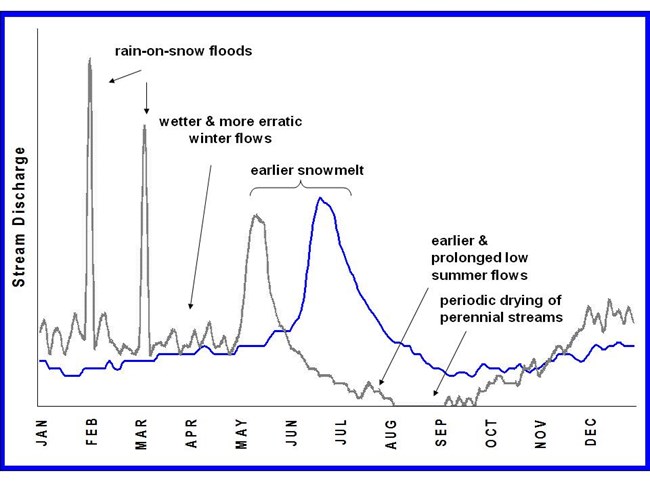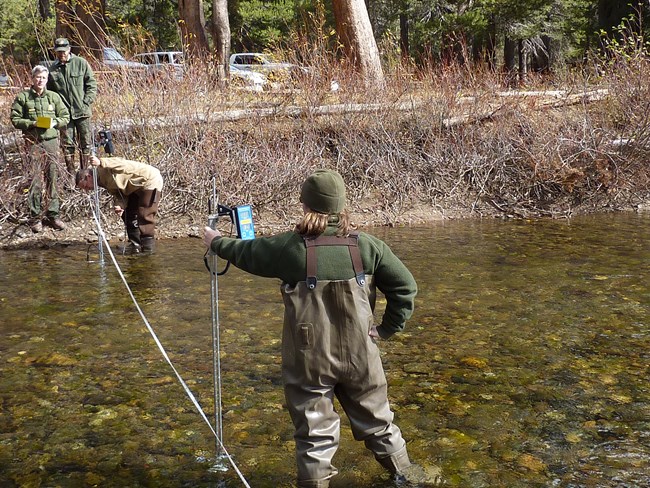Last updated: November 20, 2022
Article
River Hydrology Monitoring

Map by Sandy Graban.
Background
The Sierra Nevada Network (SIEN) parks contain the headwaters of seven major watersheds—the Tuolumne, Merced, San Joaquin, Kings, Kaweah, Kern, and Tule (Figure 1). Most of the parks’ land area is mid- to high-elevation, where snow is the major form of precipitation. As the winter snowpack melts in spring and summer, it supplies water to park ecosystems through dry summer and early fall seasons. Water from Sierra Nevada snowmelt also flows down rivers and streams to serve as a primary source of water for domestic, commercial, and agricultural use throughout California.Hydrology is the distribution and movement of water and its interactions with the surrounding environment. The SIEN river hydrology project monitors the quantity and timing of streamflow in a subset of major rivers. SIEN’s approach is to acquire data from existing stream gaging stations with long periods of record and to compile, analyze, and report on these data. Thus the SIEN staff work closely with park staff and other agencies and organizations who manage existing stream gages. These long-term data help us understand the variability in the timing and quantity of streamflow and support modeling of possible future scenarios related to a changing climate.

Adapted from David Herbst (2008)
Climate Change Impacts on Hydrology
In the coming decades, climate change will have profound effects on water resources in the Sierra Nevada and the ecosystems that have evolved within a snowmelt-driven hydrologic system. One of the most widely observed trends that will continue to affect the hydrologic cycle is an increase in air temperatures. The Sierra Nevada has warmed 0.5 to 1.5 oC over the last 50 years. In the western US, some of the most notable effects of increased air temperatures on river dynamics occur through the effects of air temperature on snow accumulation and snow melt. Air temperature influences the form in which precipitation falls, and warmer air temperatures raise the elevation of the rain-snow transition zone. In the mountains, as this zone moves upward, more precipitation falls as rain rather than snow.Researchers have documented hydrologic changes (earlier snowmelt runoff, reduced summer base flows, and decreased winter snowpack) in the Sierra Nevada and western US and predict further changes. These changes and others, including more erratic winter flows and extreme flood events, prolonged low summer flows, reduced soil moisture, and periodic drying of once perennial streams are depicted in Figure 2.
Changes in precipitation type and timing will result in longer and drier summers with less water available during the months it is most needed. Water quality and aquatic life will likely be threatened by increased flooding and erosion and lower summer flows. Streamflow data, including the volume of water in the parks’ rivers and streams, can help park and water managers to better understand and predict the timing of the delivery of snow runoff as well as the effects of climate change.

NPS / Alice Chung-MacCoubrey
Monitoring
Sierra Nevada Network and Park staff evaluated existing stream gaging stations and selected 14 gages meeting SIEN criteria to include in this monitoring project. Three of these gages receive some financial or operational support from SIEN. The river watersheds and numbers of gages included for each are as follows:- Yosemite: Merced (3) and Tuolumne (4)
- Devils Postpile: Middle Fork San Joaquin (1)
- Kings Canyon: Kings (1)
- Sequoia: Kaweah (4) and Kern (1)
Two of the Sequoia gages are downstream of the park boundary.
The objectives of the river hydrology monitoring project are to:
- Detect long term trends in timing and volume of streamflow using fixed, continuous, water stage recording stations at existing streamgages in selected major watersheds of the SIEN, and
- Record, measure, and/or calculate a set of specific hydrologic measures related to the timing and quantity of streamflow (e.g., stage, discharge, number of days to onset of snowmelt, measures related to low and high flows, and other parameters).
SIEN staff will compile existing hydrologic data from disparate sources into one central location, analyze, and report the data in a useful format to the parks and other audiences. Through this approach SIEN is able to attain the largest sample size possible and capitalize on existing data sets to achieve identified hydrologic objectives with a limited budget.
Monitoring results are shared through bi-annual reports, periodic comprehensive status and trend reports, resource briefs, newsletter articles, seasonal training sessions, and presentations. The Sierra Nevada Network website provides a project overview and links to related information, the monitoring protocol, and reports.

NPS / Alice Chung MacCoubrey
Management Applications
Information from the rivers monitoring project will:- Contribute to the understanding of the effects of climate change on the hydrology of Sierra rivers.
- Contribute to the understanding of flood dynamics.
- Contribute to the understanding of the relationships between fire and hydrology and guide fire management decisions.
- Inform park managers who oversee hydropower and other related licensing.
- Inform managers so they may plan for short- and long-term changes in surface water dynamics and the effects of those changes on park resources such as wetlands, forests, and terrestrial and aquatic wildlife.
- Be useful for resource management planning and reporting efforts, including Resource Stewardship Strategies and Wilderness Stewardship Plans.
